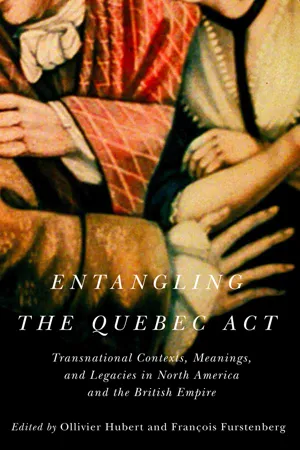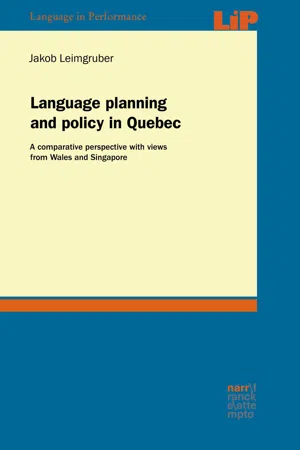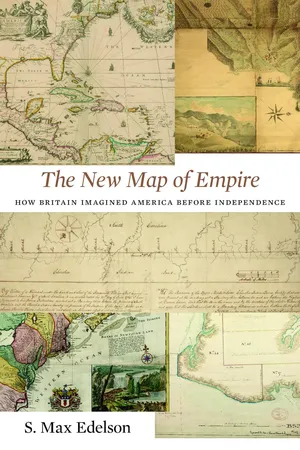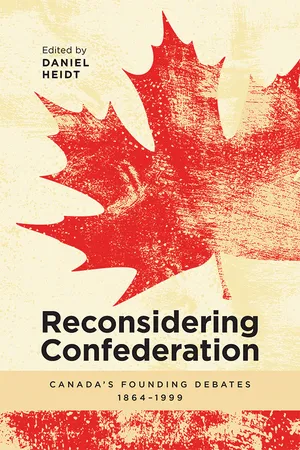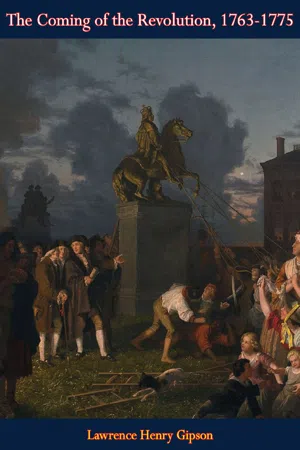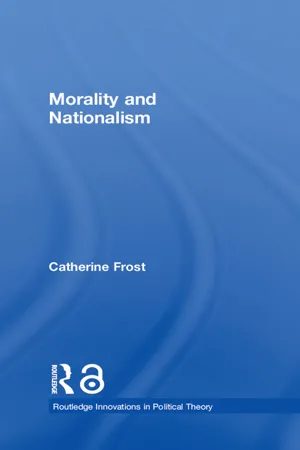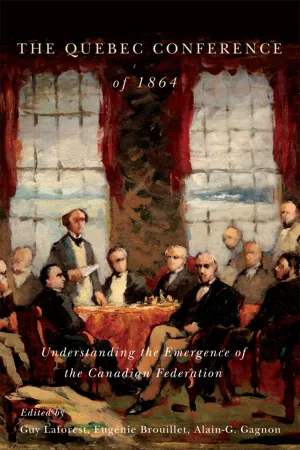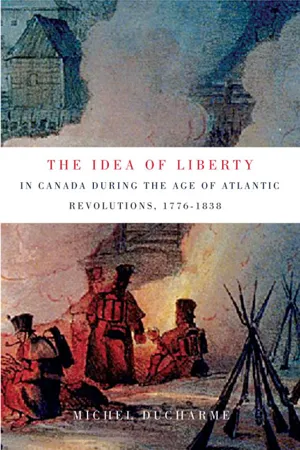History
Quebec Act
The Quebec Act of 1774 was a British law that aimed to provide religious and political rights to the French-speaking Catholic population in Quebec. It expanded the territory of Quebec to include the Ohio Valley and recognized French civil law. The act was seen as a way to maintain peace and loyalty among the French-speaking population in North America following the Seven Years' War.
Written by Perlego with AI-assistance
Related key terms
Related key terms
1 of 4
Related key terms
1 of 3
9 Key excerpts on "Quebec Act"
- eBook - ePub
Entangling the Quebec Act
Transnational Contexts, Meanings, and Legacies in North America and the British Empire
- Ollivier Hubert, François Furstenberg, Ollivier Hubert, François Furstenberg(Authors)
- 2020(Publication Date)
- McGill-Queen's University Press(Publisher)
Unlike Ouellet, however, she located the Quebec Act firmly within a British imperial framework. Imperial authorities were not trying to guarantee the fundamental rights of a Franco-Catholic population, she argued, nor were they looking south to the thirteen rebellious colonies. Rather, they hoped to solve the problem of instability in the Ohio Valley and provide for the efficient administration of the Province of Quebec. 14 In the 1970s, Pierre Tousignant made an incisive contribution to the study of the Quebec Act by exploring a vast corpus of official documents, both colonial and imperial. Fusing social, political, strategic, diplomatic, economic, and cultural perspectives, he placed the Quebec Act in a far broader context than any previous historian, casting it as both the product and the manifestation of a shift in imperial policy that followed the failure of Lord Halifax’s continental strategy. 15 Granted, the centralizing and authoritarian turn in imperial policy had been under way for several decades, as testified to by events in the Thirteen Colonies. 16 He insisted that the adoption of the Act on 22 June 1774 had to be understood in the context of the Massachusetts Government Act, passed one month earlier. Rather than seeing the Act as an ad-hoc response to local circumstances, however, he argued that it resulted from a long set of deliberations by officials in London. No historiography of equivalent richness on the Quebec Act exists in the US-based scholarship, where the American Revolution exerts an almost irresistible gravitational pull on the events of the 1770s. Framed in the context of US national history, the Quebec Act nearly always gets subsumed within the so-called “Intolerable” or “Coercive” acts that pushed British settlers towards independence. This perspective has made it impossible to understand the Quebec Act on its own terms: as legislation of national or transnational significance - eBook - ePub
Language planning and policy in Quebec
A comparative perspective with views from Wales and Singapore
- Jakob Leimgruber(Author)
- 2019(Publication Date)
- Narr Francke Attempto Verlag(Publisher)
This was unacceptable to a large majority of Catholic French Canadians. In the larger colonial context of the brewing displeasure in the nearby thirteen American colonies (soon to erupt in full-blown revolution), the British were anxious to secure the support of the Quebec population; the provisions of the Quebec Act 1774 sought to do so. This act, in addition to extending the Province of Quebec beyond the Great Lakes (to be bounded by the rivers Mississippi and Ohio, i.e. the old borders of New France without Louisiana), removed references to religion from the oath of allegiance, and declared that subjects in the province ‘may have, hold, and enjoy, the free Exercise of the Religion of the Church of Rome’ (i.e., Catholicism, Quebec Act 1774, s V); the Catholic Church was also allowed to collect tithes again. Further, it restored the use of French civil law for private law, although British common law was maintained for public law. Language is not explicitly mentioned in the Quebec Act, perhaps because French was, at the time, the single language of the overwhelming majority of residents in the province. Similarly, French still held the status of a diplomatic language, and was also spoken (in addition to English) by colonial administrators. Nonetheless, a passage in the act can be seen as granting language rights (my emphasis): [A]ll His Majesty’s Canadian Subjects within the Province of Quebec […] may also hold and enjoy their Property and Possessions, together with all Customs and Usages relative thereto, and all other their Civil Rights, in as large, ample, and beneficial Manner, as if the said Proclamation, Commissions, Ordinances, and other Acts and Instruments had not been made, and as may consist with their Allegiance to His Majesty, and Subjection to the Crown and Parliament of Great Britain […] (Quebec Act 1774, s VIII) The ‘customs and usages’ may be interpreted to include the French language as customarily and usually spoken in the conquered territory - eBook - ePub
The New Map of Empire
How Britain Imagined America before Independence
- S. Max Edelson(Author)
- 2017(Publication Date)
- Harvard University Press(Publisher)
The Quebec Act concluded a process of dividing the interior into Indian states, making space within it for possible new colonies, and, finally, establishing the largest colony in North America without any of the basic guarantees of English law. One glance at the new map of Quebec as represented by maps such as William Faden’s The British Colonies in North America (1777) made it clear that American colonists were to be pushed aside as meaningful agents of colonization. [ 235 ] The Quebec Act codified an abstract fear of future tyranny and made it visible in the present. 42 The Second Continental Congress’s justifications for breaking the “political bands” that had connected the colonies to Great Britain included the charge that the king had “abolish[ed] the free System of English Laws in a neighbouring Province, establishing therein an Arbitrary government, and enlarging its Boundaries so as to render it at once an example and fit instrument for introducing the same absolute rule into these Colonies.” Several other clauses of the Declaration of Independence took aim at the colonial order Britain attempted to impose after 1763. The king “kept among us, in times of peace, Standing Armies without the Consent of our legislatures” and made the “Military independent of and superior to the Civil power.” Not only did Britain station troops in Boston to enforce two other “intolerable” Acts—the Boston Port Act and the Massachusetts Government Act—but it had also deployed forces in newly acquired territories and concentrated ships and men in new military centers, such as St. Augustine and Halifax. When civil and military officers came into destabilizing conflict, particularly in West Florida, Britain gave ultimate authority to military commanders - eBook - ePub
- Guy Laforest, André Lecours(Authors)
- 2016(Publication Date)
- McGill-Queen's University Press(Publisher)
19The parliamentary institutions of Upper and Lower Canada were structured like Westminster.20 The Parliament of Lower Canada was composed of three legislative bodies – a governor, the Legislative Assembly, and the Legislative Council. The governor was responsible for the executive function, which was assisted by an Executive Council whose members were appointed by London.21 Until the early nineteenth century, the three branches of the legislature worked collegially, but the situation became complicated when Lower Canada members encountered the limits of their representative body within the colonial state.22 The Legislative Assembly, which was elected, marked the legal recognition of the local population’s new-found and collective sovereignty, but the governor continued to reflect the metropolitan government’s traditional sovereignty. The opposition between monarchical and popular sovereignty seemed to offer a way, in Quebec, to meet the very different interests of the imperial government and the colony’s local government.23 But the system only appeared democratic. In reality, it was distinguished by different measures of centralization: confusing and overlapping powers concentrated within the executive branch, centralized authority, impunity of public administrators, and political domination of property owners.24 The elected assembly had legislative power, but London and the colonial aristocracy held executive power over the government.25 This is where the fight for ministerial responsibility – a true parliamentary democracy – and struggles over subsidies and language use in parliamentary debates began.26 - eBook - ePub
Reconsidering Confederation
Canada's Founding Debates, 1864-1999
- Daniel Heidt(Author)
- 2018(Publication Date)
- University of Calgary Press(Publisher)
Reconciling the rights and concerns of French- and English-speaking colonists had been a major political and constitutional issue in British North America since the Treaty of Paris in 1763, which ceded New France to the British. For over a century, British authorities had imposed constitutional reorganizations on their Empire in North America without substantial input from colonists. A series of constitutional changes attempted to wrestle with the issue of integrating a large Catholic and French-speaking population into a colonial political structure administered from London. In 1774, Britain enlarged the boundaries of the province of Quebec, recognized French civil law, and permitted Catholics to take oaths that allowed them to occupy state offices. Only seventeen years later, British authorities again modified constitutional arrangements: they divided the province of Quebec into two distinct territories, Lower Canada and Upper Canada, and gave both colonies representative parliamentary institutions.Following the 1837–38 rebellions, Britain attempted to assimilate French Canada by decreeing the union of Lower Canada and Upper Canada. Despite being less populous, Canada West (the former Upper Canada) received the same number of representatives as Canada East (Lower Canada) in the new legislature that would govern both sections of the colony. The use of French in the colonial parliament was also initially disallowed, though it was subsequently restored in 1848. This attempt to assimilate French-Canadian society into a broader British North American polity was also unsuccessful. French-Canadian politicians had to address complaints from reform politicians in Upper Canada. Anxious to flex their increasing demographic muscle, Protestant political leaders wished to enhance their autonomy from the large number of Catholic voters. However, French-Canadian politicians like Louis-Hippolyte La Fontaine brilliantly used ideological differences among their English-speaking counterparts to develop workable coalitions that relied on substantial support from Francophone legislators to maintain power. For example, after the 1851 census had proved that Upper Canada had become more populated than Lower Canada, Protestants demanded “representation by population” hoping that it would guarantee their section greater autonomy from Catholic political influence. But French-Canadian allegiances with moderate Upper Canadian politicians allowed them to stonewall all attempts to implement this policy throughout the 1850s and early 1860s. This recognition among French-Canadian leaders that the French- and British-Canadian duality could be harnessed to serve their interests shaped their political thought and strategy throughout the next fifteen years. - eBook - ePub
- Lawrence Henry Gipson(Author)
- 2020(Publication Date)
- Barakaldo Books(Publisher)
But work on a permanent constitution for the province was not to be hurried. In fact, it was not until 1774 that Parliament, in the midst of the American crisis, finally passed the Quebec Act.THE PROVINCE OF NOVA SCOTIA
With the expulsion of the Acadians during the course of the late war, all portions of the Province of Nova Scotia had been opened for colonization. The response on the part of New Englanders, who knew of the fertility of the once flourishing Acadian farmlands, was prompt. Even before the peace of 1763, families from Massachusetts Bay, New Hampshire, Connecticut, and Rhode Island were making their way into the province under the inducements of Governor Charles Lawrence’s proclamation of 1759 offering lands on agreeable terms. Others followed. Many were husbandmen; some were interested in the fisheries; and a small minority, men of wealth, were mere land speculators.{326} Outside of the city of Halifax and the smaller communities established through the exertions of the British government along the eastern shore between 1749 and 1754 the province was in 1759 still largely depopulated. But by the end of 1763 it numbered close to 9,000;{327} by 1766 somewhat over 11,000{328} and by 1775 almost 20,000, three fourths of whom were New Englanders,{329} who introduced their townships and Congregational churches. Yet the New England men, numerous as they were by 1765, were impelled to acknowledge the binding power of the British connection and the authority of the provincial government—made up of the governor and Council, the Assembly, and the courts—centered at Halifax. Therefore, in spite of some hostility displayed here and there to the Stamp Act, it was enforced in Nova Scotia as well as in the province of Quebec.{330}Nova Scotia was still a financial liability to the mother country, and from its beginnings as a British buffer province in 1749 had enjoyed a yearly parliamentary grant to meet most of the ordinary expenses of conducting the provincial government. In 1766 this grant amounted to £4,936 3s . 5d. {331} Funds for defraying extraordinary expenses, such as those incurred for the payment of members of the Assembly as well as for the encouragement of agriculture and the fisheries, for the making of roads and the establishment of new settlements, and for the care of unfortunates, were in theory to be raised by various import duties and license fees. These levies, however, did not meet the public expectations and, despite the subventions from the mother country, the young colony was burdened with debt.{332} - eBook - ePub
- Catherine Frost(Author)
- 2006(Publication Date)
- Routledge(Publisher)
Quebec nationalists were concerned with the same themes of governance and cultural distinctness, and formulated their idea of the nation in ways that are already familiar from the Irish example. In this chapter I attempt to provide a synthesis of the events that inform those perspectives, and provide a sense of how the nationalism that unfolded was expressed. It is a radically digested version of events, touching only briefly on what are complex historical questions, and as with the Irish case it is intended only as a starting place for discussion. 1 And once again, I am not attempting to represent all that nationalists had to say about their cause, because of course, they said a great deal. The real value in examining nationalist argument, I contend, lies in identifying those arguments that uniquely call for a solution organized along national lines. Nationalist argument in Quebec In 1791, thirty years after its conquest by British forces, the Constitution Act divided the territory of New France in two. 2 The measure was designed to accommodate the growing population of Loyalists, who had fled the newly independent American Colonies and who were increasingly unwilling to live under the traditional French institutions left in place after the British victory. The portion of New France that became the primary refuge of the colonial loyalists was known as Upper Canada (and later Ontario); the portion that went on to become Quebec, and that continued to have a French-speaking majority, was known as Lower Canada. The Act also established a bicameral legislature in Lower Canada. The Lower House was elected and therefore dominated by French-Canadians, who were allowed the franchise - eBook - ePub
The Quebec Conference of 1864
Understanding the Emergence of the Canadian Federation
- Eugénie Brouillet, Alain-G. Gagnon, Guy Laforest, Eugénie Brouillet, Alain-G. Gagnon, Guy Laforest(Authors)
- 2018(Publication Date)
- McGill-Queen's University Press(Publisher)
Avoiding the “iniquitous pit of liberty”: The Centralizing Federalism of Joseph-Edouard Cauchon ÉRIC BÉDARDThe events leading up to the passage of the British North America Act, and the key figures who defended or fought against the Quebec Resolutions, have not received much attention from historians in recent years, at least in Quebec. Since Nature abhors a vacuum, the theme has been taken up by political scientists, who have a different approach to the past. However, following the work of Christopher Moore, I believe that we can all benefit from reviewing the course of events and the ideology that guided the leading players, if only to add nuance to existing judgments and avoid over-simplification.1Researchers hold two ideas to be true when looking at the foundation of Canada in 1867 with respect to the bloc of French-Canadian parliamentarians in the 1860s. The first is that they were fiercely opposed to legislative union. According to this point of view, the French-Canadian representatives, besides playing a fundamental role in the creation of a “federal” regime (alongside the Ontario reformers) and thereby promoting a healthy dialogue based on the sharing of sovereignty between two levels of government, were able to carve out a degree of freedom for a minority national community. This federal regime, as explained by political scientist Guy Laforest and legal expert Eugénie Brouillet in their respective studies, was then denatured by the Constitution Act, 1982.2 The second idea that has gained general acceptance, because multiple traces of it can be seen in the debates of 1865, is that the support of French-Canadian conservatives for the Quebec Resolutions was based on a fear of American hegemony. The fears raised by the theory of manifest destiny proposed by US intellectuals and politicians in the northern camp, including the powerful Secretary of State William Seward, a close advisor to President Abraham Lincoln during the US Civil War,3 - Michel Ducharme(Author)
- 2014(Publication Date)
- McGill-Queen's University Press(Publisher)
This was perfectly logical, since for the moderns, participation in power was not equivalent to liberty itself; it constituted one liberty among others. Thus, “A Citizen of Quebec” objected to the granting of an assembly, arguing that the province’s subjects were not living under an oppressive regime. He added that if an assembly were granted, it would be to the advantage of those English who had ties to the mother country. Finally, he contended that Canadians already enjoyed as much freedom as it was possible to have. On the one hand, the Quebec Act guaranteed “their religion, liberties and laws”; on the other, “the people of Canada are in fact well satisfied with the present form of government; their personal liberty is secured to them by an Ordinance… which gives them the benefit of the Writ of Habeas Corpus… Their property is protected by laws, usages, and customs of Canada, to which, by long experience of their fitness for their country, they are strongly attached. Their laws are by no means unfavorable to commerce” (Citizen of Quebec, Observations, 12, 16). 24 Price, “A Discourse on the Love of Our Country,” in Political Writings, 190. 25 Galarneau, La France devant l’opinion, 335. 26 F. Murray Greenwood has argued that the real threat in the eyes of British politicians was to be found in American Republicanism and not the French Revolution (Legacies of Fear, 61–2). 27 Brun, La formation, 12–14
Index pages curate the most relevant extracts from our library of academic textbooks. They’ve been created using an in-house natural language model (NLM), each adding context and meaning to key research topics.
Explore more topic indexes
Explore more topic indexes
1 of 6
Explore more topic indexes
1 of 4
